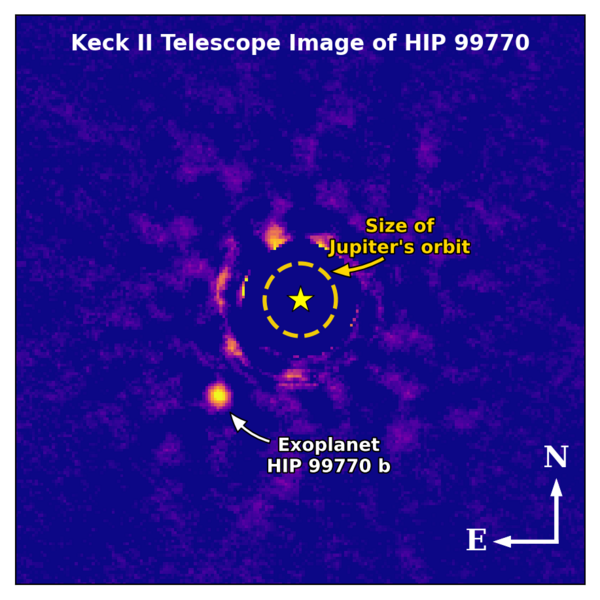
Astronomers in 2020 detected and took a direct image of a gas giant planet that orbits a star about twice as massive as the sun, and a recent publication in the journal Science describes the breakthrough process that led to the discovery.
Researchers, including those at the University of Notre Dame, discovered the gas giant planet by combining two different approaches: First, they inferred the planet’s existence using a data-driven method. Next, Notre Dame researchers captured and confirmed the image of the planet using the Subaru Telescope operated by the National Astronomical Observatory of Japan (NAOJ) and the Keck Observatory, both located on Mauna Kea in Hawaii.
“This is very exciting,” said Jeffrey Chilcote, assistant professor in the Department of Physics & Astronomy, who specializes in observing and building the highly sensitive instruments to directly image exoplanets and whose lab members imaged the planet at Keck. “Discovering this planet means that using this method, we’re going to continue to find more planets using this technique.
“It also gives us a new planet for astronomers to test atmospheric models on, to understand what planets look like.”

Astronomers have detected more than 5,000 exoplanets, which are planets that orbit stars other than our sun, through indirect methods. When using indirect methods, astronomers infer the existence of a planet because of a “wobble” detected by analyzing the star’s spectrum, or identifying changes in the star’s brightness as the planet passes between Earth and a distant star. However, only about 20 planets — including this latest planet, HIP 99770 b — have been imaged directly, partially because the technology is new, and also because it takes a long time to find the planets to image in the first place.
Chilcote is part of the team that built the Coronagraphic High-Resolution Imager and Spectrograph (CHARIS), which is coupled to the NAOJ’s Subaru Coronagraphic Extreme Adaptive Optics (SCExAO) instrument that imaged the planet. Traditionally, astronomers who wanted to directly image planets did blind searches, looking for the presence or absence of stars in an “unbiased” way.
In the new strategy, Thayne Currie, of the NAOJ, the University of Texas-San Antonio, and Eureka Scientific, first used an indirect method. Using the Hipparcos-Gaia Catalog of Accelerations to determine the precise location of stars in the sky, a process called astrometry, he and collaborators identified a star that appeared to change position in the sky. This catalog combines data from two star-mapping missions, Hipparcos and Gaia, separated by 25 years, at which point astronomers can determine which stars appeared to be moving in an abnormal way—suggesting a gas giant planet was orbiting them.
Next, researchers turned to the Subaru telescope (that includes Chilcote’s CHARIS) to directly image HIP 99770 b.
The new planet is larger than Jupiter, and is further from its star than Jupiter is from the sun. But because the sun HIP 99770 b orbits is significantly larger, its conditions could be similar to those in our outer solar system.
“The most exciting thing in finding this planet is that this new technique works, and this ‘biased’ method of finding planets is going to expand the number of planets we can directly image, allowing us to see the spectrum of the planet and measure its atmosphere,” Chilcote said.
And there will be more discoveries to come from this method. HIP 99770 b was one of the first stars observed from the Gaia candidates. The team is analyzing data from around 50 other stars, and they expect that there will be more discoveries in the future.
“[HIP 99770 b] is a proof of concept of this new strategy for finding imageable planets that will get far better in the next five years,” Currie said in a news release.
Discoveries like this are the epitome of what astronomers hope to see right now, and even though it takes time to verify and publish results, each new discovery leads to information about where we came from and whether there’s other life in the universe.
“This planet is going to give future astronomers, essentially, a target they can study for many, many years, to learn about its history and where it fits into the space of planetary physics,” Chilcote said.
In addition to Currie and Chilcote’s involvement, Taylor Tobin, a former postdoctoral fellow in Chilcote’s lab, assisted with the discovery by handling some of the data. Other institutions involved in the project include the University of California, Santa Barbara, Santa Barbara, California; Princeton University, Princeton, New Jersey; University of Texas-Austin, Austin, Texas; Astrobiology Center, Osawa, Mitaka, Tokyo, Japan; Steward Observatory, The University of Arizona, Tucson, Arizona; National Astronomical Observatory of Japan, Osawa, Mitaka, Tokyo, Japan; The University of Tokyo, Tokyo, Japan; Columbia University, New York, New York; State University of New York-Stony Brook, Stony Brook, New York; NASA-Goddard Space Flight Center, Greenbelt, Maryland; National Research Council-Herzberg, Victoria, British Columbia, Canada; University of Victoria, Victoria, British Columbia, Canada; University of Sydney, Sydney, Australia; California Institute of Technology, Pasadena, California; Universite Cote d’Azur, Observatoire de la Cote d’Azur, Laboratoire Lagrange, Nice, France; Stockholm University, Stockholm, Sweden; George Mason University, Fairfax, Virginia; University of Hawaii, Hilo, Hawaii; and Polish Academy of Sciences, Torun, Poland.